|
|
West Australian

|
|
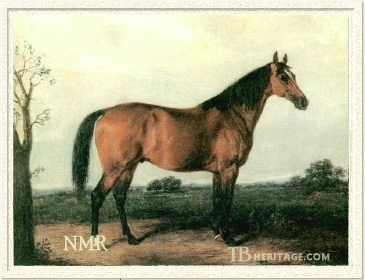 |
|
|
West Australian garnered his place in the annals of the British turf as the very first winner of the Triple Crown, consisting of the Two Thousand Guineas, the Derby, and the St. Leger. As a stallion, he was considered to be a disappointment, both in Britain and in France, where he stood the latter years of his life. However, West Australian, despite his limited success, breathed new life into the male line of his ancestor, Matchem, grandson of the Godolphin Arabian, a line which was severely languishing in comparison to that of the male line of Eclipse, descendant of the Darley Arabian.
West Australian was foaled in 1850, and was bred and owned by John Bowes, illegitimate son of John Bowes, 10th Earl (later Baron) Strathmore. Unable to inherit his father's title, as he was born nine years before his parents married, young Bowes nevertheless was well taken care of financially, and used some of his fortune to invest in his love of the turf. The gem of his breeding operation was the Whisker mare Emma, bred by the trustees of Lord Strathmore, but who became the property of Bowes outright when he attained legal age.
A very modest race filly, Emma only won three minor races, but as a producer, she made a name for John Bowes as a breeder of classic champions. Her first classic winner was the Catton colt Mundig, who captured the Derby in 1835, when Bowes was just 21 years old. An older full brother to Mundig, Trustee, had placed third in the 1832 Derby to St. Giles.
|
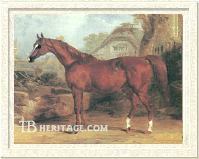
Emma, West Australian's granddam
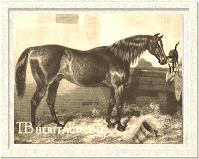
Melbourne | |
Emma's next classic champion was Cotherstone, by Touchstone, which won the Two Thousand Guineas and Derby for Bowes in 1843. That same year, at the age of nineteen, Emma foaled a full sister to Cotherstone. Named Mowerina, she was a decent filly, placing second in the One Thousand Guineas, but put to the broodmare paddocks, she continued the grand producing tradition of her dam. In addition to West Australian, she foaled six other stakes winners, the best of which was Victoria, a full sister to West Australian, who won the Yorkshire Oaks and placed third to Mincepie in the Oaks, three years after West Australian blazed to classic glory.
West Australian was sired by Melbourne, a prolific stallion who in his stud career, sired a total of seven classic winners. His best colt before West Australian was Sir Tatton Sykes, winner of the Two Thousand Guineas. His daughters were exceptional, as five of his seven classic winners were fillies, including the great racemare Blink Bonny. But West Australian, upon being sent to John Scott's Whitehall stable near Malton, soon gave every indication that he possessed considerable talent. In a trial in late summer, West Australian easily beat the good four-year-old Longbow, who was fresh off a smart victory in Goodwood's Stewards Cup. |
West Australian on the Turf
West Australian was described as a "yellowish bay, rather long in the body, with a low stealing action that gave nothing away." The colt had a propensity to be a bit overweight, and this was coupled with recurrent lameness. He was difficult to get into proper racing trim, and as a two-year-old, was not seen under colors until October at Newmarket, in which he ran a modest second to Speed the Plough. His only other race at two was that same week, the six furlong Glasgow Stakes, in which West Australian gained his revenge upon Speed the Plough.
West Australian was then rested until spring, and did not make his three-year-old debut until the Two Thousand Guineas. His long vacation had no ill effects on his sharpness, as he won by a deceptively easy half a length from the Duke of Bedford's colt Sittingbourne. This victory sent West Australian to Epsom as the strong favorite for the Derby. Though 28 horses took part, when the field reached Tattenham Corner, the issue lay between three of them--Cineas, who was in the lead, followed by West Australian and Sittingbourne. Under Frank Butler, West Australian went by Cineas and won by a neck from Sittingbourne, who had also closed well, with Cineas only a head farther back.
West Australian did not run again until the autumn and the St. Leger. It could not even be described fairly as a race, as the Bowes colorbearer won in a canter, and his jockey, Frank Butler exclaimed "I only touched him with the whip once and I was glad to get him stopped."
The rest of West Australian's season comprised two walkovers, no challengers wanting any part of the first Triple Crown champion.
At four, West Australian ran only three times, and won each time. He won the Triennial Stakes at Ascot as a prep for the Ascot Gold Cup, which he also won in masterful fashion. He concluded his racing career winning a sweepstakes at Goodwood by twenty lengths. In all, West Australian faced the starter ten times and was defeated only once, with two walkovers.
West Australian in the Stud
John Bowes did not keep his prize racehorse. Instead, he turned a tidy profit by selling West Australian to Lord Londesborough for 5000 guineas. Londesborough stood West Australian at Kirkby Farm near Tadcaster for a fee of thirty guineas, and West Australian remained there until Lord Londesborough died in 1860. West Australian was purchased by the Duc de Morny, a half-brother to Napoleon III, for 4000 guineas, and was sent to serve mares in France at Haras de Viroflay. When de Morny died in 1862, West Australian was moved to the French National Stud at Haras du Pin. It is interesting to note that while at Kirkby, West Australian, then arguably the world's greatest race horse, stood alongside Stockwell, who would become one of Britain's greatest sires, with twelve classic winners to his credit, thus earning him the nickname "Emperor of Stallions."
Sadly, West Australian never came close to matching the feats of his more celebrated stable mate. He was characterized as an unsuccessful stallion. In the short run, this may have been valid. However, a closer look at his sire record reveals that he was a decent sire who became an important influence upon succeeding generations.
His son THE WIZARD won the Two Thousand Guineas, was second to Thormanby in the Derby, and third in the St. Leger. The Wizard also captured the Ascot Derby and defeated Thormanby in the Grand Duke Michael Stakes. The Wizard won several other stakes. In 1862 he was purchased for stud in Prussia.
|
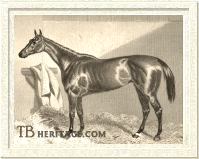
Summerside
| |
MICHAEL SCOTT was a son of West Australian noted for his stoutness. He once won four races in the space of two days, and during another two day span, won three races. He did not, however, become a noteworthy stallion.
West Australian's daughter SUMMERSIDE was a lovely brown filly with a star on her forehead and a petite build -- she stood only 15.2 hands high. Bred by Admiral Harcourt, she was sold to Lord Londesborough, in whose colors she raced. She was backwards as a two-year-old and won only a modest sweepstakes at Doncaster. At three she became a classic winner, capturing the Oaks, defeating the One Thousand Guineas heroine, Mayonaise, in the process. Mated several times with Stockwell, she did not produce anything of high class. |
In France, West Australian sired JEUNE PREMIERE, a victress in the classic Prix de Diane. A son he sired while standing at Haras du Pin, Ruy Blas, won fourteen of his nineteen races, including several minor races in France. His biggest win came in the Grosser Preis Baden-Baden in Germany. Retired to stud in France, he was arguably better than his sire, for he came up with three extraordinary fillies--Destinee, Nubienne, and Serpolette II, all winners of the Prix de Diane. Nubienne also captured the Grand Prix de Paris.
Ruy Blas also figured in jumping pedigrees, as his son Verdun sired Boissy, a winner of the Grand Steeplechase de Paris, while another son, Mourle, sired Fleurissant, also a winner of the Grand Steeplechase de Paris.
|
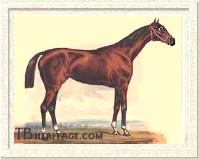
Ruy Blas
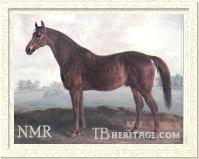
Australian. National Museum of Racing. Used with Permission.
| |
West Australian left a lasting legacy through two of his sons, AUSTRALIAN and Solon, which assured the survival of the Godolphin Arabian male line. Australian, foaled in 1858, never represented his sire on a British racetrack. Bred by W. E. Duncombe in England, the colt was purchased as a foal along with his dam, the Young Emilius mare Emilia, by A. Keene Richards, master of Blue Grass Park near Georgetown, Kentucky. Horseman Ten Broeck had acted as agent in the deal, and the newly-purchased mare and her colt set sail for the states.
As a racehorse, Australian won over a mile and over two miles, but was not a spectacular racehorse. In 1861, the colt was sold by Richards to his friend, Robert Aitcheson Alexander, owner of Woodburn Stud near Midway, Kentucky. Alexander also purchased the colt's dam, Emilia. Under Alexander's colors, at age four he ran once, placing third. Upon Australian's retirement from the turf, he was sent to the lush paddocks of Woodburn, joining the great Lexington in the stallion barn. This was much the same scenario his sire West Australian had gone through before him, sharing the stud barn with a more heralded resident.
As a stallion, Australian was a pronounced success. He never rivaled Lexington, but then Lexington had the choicest mares sent to his court. Australian was also never able to overtake his stable mate on the sire lists, but finished second on the list to him six times, and his blood crossed very well with that of Lexington, as evidenced by the exploits of Spendthrift, the best get of Australian.
|
Foaled in 1876 from Lexington's daughter Aerolite, Spendthrift was bred by Woodburn and sold to Daniel Swigert, who later resold him to James R. Keene. Spendthrift was the first great champion to carry Keene's colors of white and blue dots, and counted the Belmont Stakes among his nine victories in sixteen starts. At stud, his best progeny included Kingston, winner of over 80 races and leading sire in 1900 and 1910; Lamplighter; and the fiery Hastings, another Belmont Stakes winner and leading sire in 1902 and 1908, the sire of Fair Play. From Fair Play, a leading American sire three times, came Man o'War and Display, both important stallions.
Man o'War is today the link in the continuation of the male line of West Australian. Though he sired a number of outstanding racing colts, it is through a less accomplished son on the racetrack, the ill-tempered War Relic, that the line has flourished, with such stallions as Intentionally, In Reality, and Relaunch which have kept the line going.
Australian was the sire of an older full brother to Spendthrift. Named Fellowcraft, this colt was a very good racehorse in his own right, and his history rests with the fact that he broke the immortal Lexington's record for four miles. Fellowcraft was the broodmare sire, through his daughter Lady Reel, of Hamburg, a champion on the racetrack and a leading sire. Australian was also the sire of American classic winners Baden-Baden, Joe Daniels, and Springbok.
Australian sired many fine producing daughters, the best of which was Maggie B.B., dam of English classic champion Iroquois and American classic winners Harold and Panique. Maggie B.B.'s family later included champions Sir Dixon, Whisk Broom II, Crusader, and Top Flight. American Broodmare of the Year Fall Aspen traced directly in the female line to Maggie B.B., granddaughter of West Australian.
The primary sire son West Australian left behind in the British Isles was SOLON, an Irish raced colt produced from a daughter of Birdcatcher. Solon's biggest victory came in the Great Surrey Foal Stakes, his only win in England. All his other victories were scored in Ireland. He was a tough horse, both physically and mentally, as he once won three races from four starts in the space of two days, and was noted for an evil temperament which he passed on to many of his descendants, including his best son, Barcaldine, who was undefeated in twelve lifetime starts. Retired to Park Paddocks at Newmarket at a fee of 50 guineas, Barcaldine became an very successful stallion, and through him, the line of West Australian was perpetuated in Great Britain.
Although he got a dual-classic winning son, Sir Visto, and several other high class racing sons, it was through Marco, an average runner, that kept the sire line thread from West Australian going even further.
Foaled in 1892, Marco was a stunning chestnut foaled from the Hermit daughter Novitiate. In fact, Marco was said to resemble Hermit more closely than any of his paternal ancestors. At stud, Marco came up with Neil Gow, winner of the Two Thousand Guineas, and Omar Khayyam, who was imported to the United States, where he won the Kentucky Derby and many other races and as a stallion was eight times in the top twenty leading sires and in 1925 the leading sire of juveniles. Marcovil, a son of Marco, came up with the great Hurry On.
Hurry On was a mammoth chestnut colt who raced during the bleakest year of the first World War--1916. As a stallion, he was arguably one of the best procreating descendants of West Australian, for he sired seven classic winners, including three winners of the Derby--Captain Cuttle, Call Boy, and Coronach, as well as Ascot Gold Cup champion Precipitation, himself sire of four classic winners.
As a broodmare sire West Australian was only moderately successful. His daughter LADY SEFTON became the dam of Sefton, a Speculum colt which became his sire's only classic champion, when he captured the Derby of 1878 and also ran third in the Two Thousand Guineas. Sefton was not a success at stud and suffered greatly from rheumatism. He was put down at the age of sixteen in 1891.
West Australian's most significant contribution as a broodmare sire came via an UNNAMED daughter out of the Camel mare Brown Bess. The foal from this unnamed daughter was Musket, winner of the Ascot Stakes and the Queen Alexandra Stakes. In Britain, he left Petronel, a winner of the Two Thousand Guineas. Exported to New Zealand, he sired many stakes winners, including Martini Henry, Volley, Maxim, Manton, Pearlshell, and Trenton. But his finest offspring was Carbine, winner of the Melbourne Cup under 145 pounds in record time, as well as 32 other races from 43 lifetime starts. Exported to England later in life for stud duty, he came up with classic winner Spearmint, whose daughter Plucky Liege became a highly influential broodmare.
West Australian died at the age of twenty on May 2, 1870 at Haras du Pin, three days before the death of Stockwell. A champion on the racetrack, and the first winner of England's Triple Crown, West Australian failed to get much notice in death. The Sporting Times devoted a whole page to "The deaths of Stockwell and West Australian." Overshadowed by Stockwell in the stud during those long-ago days at Kirkby Farm, so too, was West Australian in this dual obituary, for West Australian was given only two sentences at the end of the story. Later, West Australian was accorded some measure of the respect he deserved when a small stone memorial commemorating his triumphs on the turf, was erected on the grounds of Bowes' Streatlam Castle, which can still be seen today.
--Liz Martiniak
|
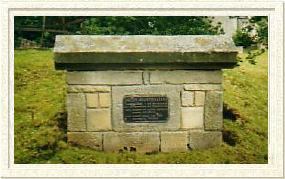
West Australian's memorial stone at Streatlam. Photo ©Jane Cook.
|
|
|
|

